| Bracco Italiano | |||||||||||||||||||||||
|---|---|---|---|---|---|---|---|---|---|---|---|---|---|---|---|---|---|---|---|---|---|---|---|
 | |||||||||||||||||||||||
| Other names |
| ||||||||||||||||||||||
| Origin | Italy | ||||||||||||||||||||||
| |||||||||||||||||||||||
| |||||||||||||||||||||||
| Dog ( domestic dog ) | |||||||||||||||||||||||
The Bracco Italiano [lower-alpha 1] is an Italian breed of pointing dog.
| Bracco Italiano | |||||||||||||||||||||||
|---|---|---|---|---|---|---|---|---|---|---|---|---|---|---|---|---|---|---|---|---|---|---|---|
 | |||||||||||||||||||||||
| Other names |
| ||||||||||||||||||||||
| Origin | Italy | ||||||||||||||||||||||
| |||||||||||||||||||||||
| |||||||||||||||||||||||
| Dog ( domestic dog ) | |||||||||||||||||||||||
The Bracco Italiano [lower-alpha 1] is an Italian breed of pointing dog.
The first dog registered by the Kennel Club Italiano, founded in 1882, was a Bracco Italiano. [2] Early in 1949 a breed standard was approved by the Ente Nazionale della Cinofilia Italiana, and later the same year a breed society, the Società Amatori Bracco Italiano, was formed. [3] [4] The breed was fully accepted by the Fédération Cynologique Internationale in 1956. [5]
In the 41 years from 1970 to 2011, a total of 24,613 of the dogs were registered. [3] From 2010 to 2018 there were approximately 700 new registrations per year in Italy, of which in every year the majority were of white-and-orange colouration. [6]
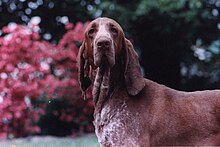

The Bracco Italiano is roughly square in outline – the height at the withers is almost as great as the length of the body. The head is large, with long ears and long upper lips that hang below the lower jaw. [7]
The coat is dense and short. It may be white, or white with patches of either orange or brown, or white with orange or brown roaning. Any other colour, including black or tricolour markings, is considered disqualifying fault. [7] The most usual colours are bianco-arancio (white-and-orange) and roano-marrone (liver roan). [6]

The Italian Greyhound or Italian Sighthound is an Italian breed of small sighthound. It was bred to hunt hare and rabbit, but is kept mostly as a companion dog.
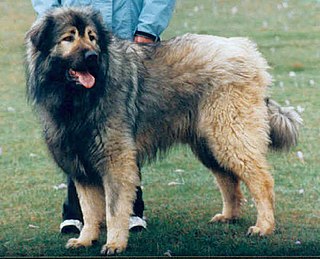
The Šarplaninac or Sharr dog is a breed of dog of livestock guardian type. It is named for the Šar Mountains or Šar Planina range in the Balkans, where it is principally found. It was recognised by the Fédération Cynologique Internationale as the Illyrian Shepherd Dog or Ilirski Ovčar from 1939 until 1957, when the name was changed to Yugoslavian Shepherd Dog – Sharplanina or Jugoslovenski Ovčarski Pas – Šarplaninac.

Griffon is a type of dog, a collection of breeds that were originally hunting dogs. There are three lines of the griffon type recognized by the Fédération Cynologique Internationale (FCI): the Griffon Vendéens, the wirehaired pointers, and the smousje. The griffon type is characterized by rough- or wire-hair.

The Bergamasco Shepherd, Italian: Cane da Pastore Bergamasco, is an Italian breed of sheepdog. It originated in the Alpi e Prealpi Bergamasche, where it was used as a herding dog for both sheep and cattle.

A kennel club is an organization for canine affairs that concerns itself with the breeding, showing and promotion of more than one breed of dog. Kennel clubs became popular in the mid 19th century. All-encompassing kennel clubs are also referred to as 'all-breed clubs', although "all" means only those breeds that they have decided to recognize, and "breed" means purebred dogs, not including dog hybrids and crossbreeds or mixed-breed dogs. A club that handles only one breed is known as a breed club.
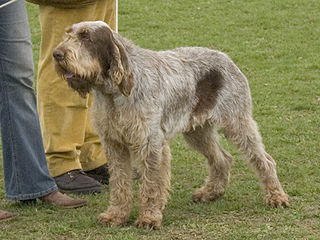
The Spinone Italiano is an Italian breed of hunting dog, traditionally used for tracking, for pointing and for retrieving game.

The Cane Corso is an Italian breed of mastiff. It is usually kept as a companion dog or guard dog; it may also be used to protect livestock. In the past it was used for hunting large game, and also to herd cattle.

The South Russian Ovcharka or South Russian Shepherd Dog is breed of flock guardian dog. It developed in the areas of the Russian Empire and the Soviet Union that are now Ukraine and southern Russia, and is thought to derive from cross-breeding between local dogs of the Russian steppes and long-haired shepherd dogs brought to the area from Spain in the late eighteenth century together with Merino sheep. These may have been similar in appearance to the present-day Gos d'Atura Catala.
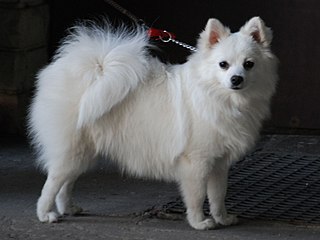
The Volpino Italiano or Volpino is an Italian breed of dog of Spitz type. It is closely related to the Pomeranian and to the German Spitz.
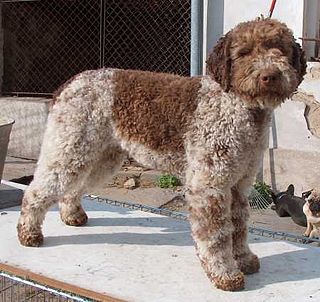
The Lagotto Romagnolo is an Italian breed of dog. It originates in the marshlands of the Delta del Po in the eastern part of the Romagna sub-region of Italy. The name derives probably from the term “lagotto” which is the name of the inhabitants of the local town of Lagosanto. Another theory believes it comes instead from Romagnol can lagòt, meaning "water dog". Its traditional function was as a gun dog, specifically a water retriever; since the drainage of large areas of wetland habitat in its area of origin, it is now more often used to hunt for truffles.

The Appenzeller Sennenhund is a Swiss breed of medium-sized working dog. It originates in the Appenzell region of north-eastern Switzerland, and is one of four regional breeds of Sennenhund or Swiss mountain dog, all of which are characterised by a distinctive tricolour coat.

The Cirneco dell'Etna is an Italian breed of hunting dog from the Mediterranean island of Sicily. It is named for the Etna volcano in eastern Sicily. It has a keen sense of smell, and is used to hunt small game, particularly rabbits. As with many working dogs, registration is conditional on successful completion of a working trial.

The Segugio Italiano is either of two Italian breeds of dog of scent hound type, the wire-haired Segugio Italiano a Pelo Forte or the short-haired Segugio Italiano a Pelo Raso. Apart from the coat type, they are closely similar, and in some sources may be treated as a single breed; the Fédération Cynologique Internationale and the Ente Nazionale della Cinofilia Italiana treat them as separate. They are also genetically close to the other two Italian scent hound breeds, the Segugio Maremmano and the Segugio dell'Appennino. They are traditionally used for hunting hare, but may also be used in boar hunts.

The White Swiss Shepherd Dog or Berger Blanc Suisse is a Swiss breed of shepherd dog. It descends from North American White Shepherds imported to Switzerland; the White Shepherd itself descends from white-coloured purebred German Shepherds.

The Neapolitan Mastiff or Mastino Napoletano is an Italian breed of large dog of mastiff type. It descends from the traditional guard dogs of central Italy. It was recognised as a breed by the Ente Nazionale della Cinofilia Italiana in 1949, and accepted by the Fédération Cynologique Internationale in 1956.

The Rastreador Brasileiro is a large breed of dog from Brazil, first recognised by the Fédération Cynologique Internationale in 1967, but an outbreak of disease, compounded by an overdose of insecticide, wiped out the breed's entire breeding stock. The FCI and the Brazilian Kennel Club then declared the breed extinct in 1973 and delisted it. Since then, efforts have been made to re-create the breed. The Rastreador Brasileiro is a hunting dog of the scenthound type. The breed is also known by the names Urrador or Urrador Americano, in reference to the American (U.S.) coonhounds in its background. In 2013, the Brazilian Kennel Club (CBKC) officially re-recognized the breed. The FCI Breed Standard was produced in 2019.
The Segugio dell'Appennino or Piccolo Lepraiolo Italiano is an Italian breed of small scenthound, bred specifically to hunt hare. It may be either smooth-haired or wire-haired. It is one of four Italian breeds of scenthound, the others being the Segugio Italiano a Pelo Forte, the Segugio Italiano a Pelo Raso and the Segugio Maremmano. It received full recognition from the Ente Nazionale della Cinofilia Italiana in 2010; it is not recognised by the Fédération Cynologique Internationale.

The Segugio Maremmano is an Italian breed of scent hound from the coastal plains of the Maremma, in Tuscany. It is mainly used for hunting wild boar, but may also be used to hunt hare and other mammals. They may be either smooth-haired or rough-haired.

The Ente Nazionale della Cinofilia Italiana, usually known as the ENCI, is the national organisation responsible for the recognition, standardisation and registration of pedigree dogs in Italy. It is sometimes called the Italian Kennel Club.